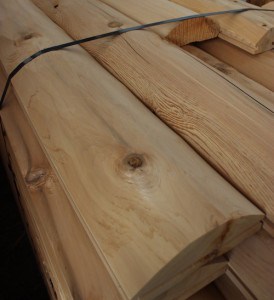What’s the Difference Between White Cedar and Red Cedar Log Siding?
 At first glance, it may be difficult to spot the differences between Northern White Cedar and Western Red Cedar log siding. Both have that spicy aroma that inspires cedar-lined closets, attics and trunks. Both have a similar face grain. And both are trusted for interior and exterior building thanks to their durability and natural resistance to decay and insect damage.
At first glance, it may be difficult to spot the differences between Northern White Cedar and Western Red Cedar log siding. Both have that spicy aroma that inspires cedar-lined closets, attics and trunks. Both have a similar face grain. And both are trusted for interior and exterior building thanks to their durability and natural resistance to decay and insect damage.
But take a closer look to compare these two wood species for log siding, and you’ll see that though both are great choices, there are notable differences.
White Cedar vs Red Cedar: Physical Characteristics
It’s difficult to compare these two trees side-by-side in nature since they don’t typically grow in the same regions. Northern White Cedar, for example, is more prevalent in southern Canada and around the colder, swampy regions of the Great Lakes. Their leaves differ in color, as does their cone scale formation. The most obvious difference between the two trees is their size. Western Red Cedar trees tower — some may grow has tall as 200 feet with 10 foot trunks. Northern White Cedar trees are considerably smaller and slimmer, reaching heights of around 50 feet with trunk diameters of about 2 feet.
White Cedar vs Red Cedar: It’s What’s Inside That Counts
Cut into these two trees, and the color of the wood differs greatly. Western Red Cedar gets its name from its red color, while Northern White Cedar is lighter and has a yellow hue. Make a crosscut into the trunk, and you’ll see that both trees have two rings. The outer, lighter color ring is the sapwood. While sapwood is essential to tree growth, it is more susceptible to shrinking, cracking and decay once cut — translating to more home maintenance for your clients.
The inner, darker ring is called the heartwood, and this is the strongest section of the tree. This is what you want your log siding and other wood building products to contain. Western Red Cedars grow significantly bigger than their Northern cousins, so they contain a larger ring of sapwood. Because Northern White Cedar has a thinner band of sapwood (about ¾ inch on a 10-inch log), log siding milled from this species contain more of the tree’s heartwood. In fact, almost 100 percent of Northern White Cedar log siding contain heartwood; only about 10 percent of Western Red Cedar log siding pieces contain heartwood.
Northern White Cedar is Heartwood Mills’ preferred wood for log siding because of its many benefits, including strength, durability and weather, rot and insect resistance. Learn more about why we believe it’s the superior choice for log siding.
Of course, every wood species has its own set of pros and cons. Talk to the experts at Heartwood Mills about your next project. They can help you select the right log siding and other building products from our full line of milled wood products, from Northern White Cedar, White Pine and Western Red Cedar to Douglas Fir and Maple.
